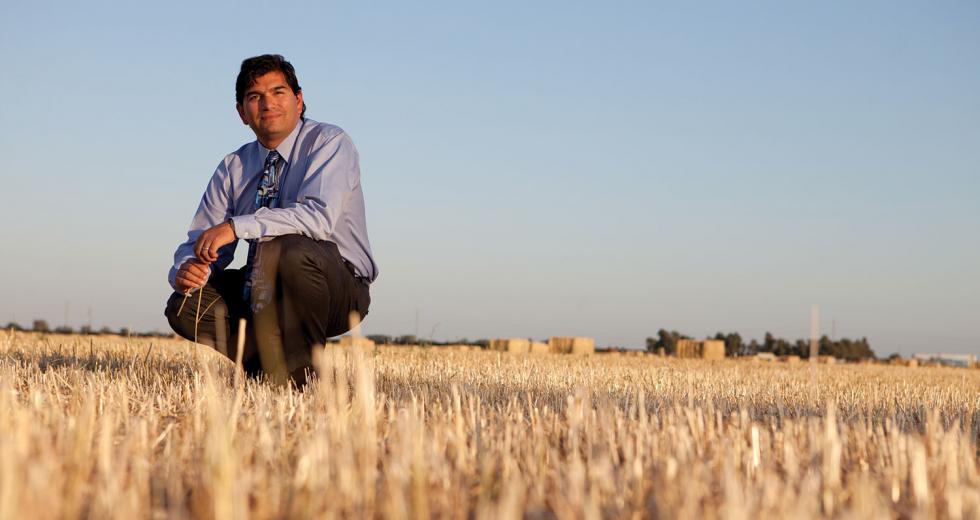Immediately south and southeast of Elk Grove are thousands of acres of mostly undeveloped farmland that officials think the city will someday need. The plan is to add nearly 8,000 acres — about 29 percent of Elk Grove’s current size — to its fold. But critics say Elk Grove has plenty of unused land within its borders, and California is losing farmland fast.
City leaders created this initial expansion plan, known as a sphere of influence, in 2007. But due to the regulatory process, there is still no deal.
The countywide Local Agency Formation Commission (LAFCo) is working on the required environmental documents and circulating a modified environmental impact report. “From what we understand, we should be in a position to have a hearing by the end of this year,” says Taro Echiburu, special projects manager for Elk Grove.
There’s no question that establishing a sphere of influence is Elk Grove’s first step toward annexing the land, but the timeline could grow longer and longer. The same thing happened to Folsom in 2001 when it brought 3,585 acres south of Highway 50 into its sphere of influence. In January — more than a decade later — its application to annex the land finally was approved.
“I don’t believe that, even from the very beginning, the council was thinking that annexation was something that would be quick,” Echiburu says. “It’s not so much a matter of necessity right now or 10 years from now. It’s a matter of being ready and having the tools so that when the city is ready to move forward, there is a clear path to follow.”
Elk Grove has seen what happens to development when the economy heats up. Even before incorporation, Sacramento County mapped out the East Franklin Specific Plan Area for what would become Elk Grove. It was expected to take more than a decade to build out, Echiburu says. Instead it was nearly 60 percent built within four years.
“So, certainly, the city has seen the effects of very rapid growth and not enough time to plan,” he says. “The results of that were half-built streets, infrastructure that was not keeping up with the pace of development.”
With an official sphere of influence, Elk Grove could essentially pre-zone the land before annexation. The city wouldn’t have carte blanche, however. It first needs permission from LAFCo, which is free to impose restrictions.
When Folsom was looking to grow, the commission required the city to preserve oak woodlands within the area to be annexed, according to LAFCo Executive Officer Peter Brundage. Folsom also had to identify a water supply.
In Elk Grove’s case, conservation of agricultural land would likely be the sticking point, Brundage says.
“It’s not so much a matter of necessity right now or 10 years from now. It’s a matter of being ready and having the tools so that when the city is ready to move forward, there is a clear path to follow.”
Taro Echiburu, special projects manager, city of Elk Grove
The ag land in Elk Grove’s proposed sphere of influence produces about $14 million in raw commodities annually, says Charlotte Mitchell, executive director of the Sacramento County Farm Bureau, and she sees no justification for scheduling its development.
“When you stand in the middle of Elk Grove, you see a mall that
has been half built … and the developer who owns it can’t pin
down a time when that mall might be finished,” Mitchell says.
“And you see open areas of vacant land still within the city
boundaries that are looking to be infilled, and the city has lost
its core center.”
Nurture Elk Grove’s center before expanding, she urges.
Just knowing that the land could cease agricultural productivity in 10 years is enough to keep some landowners from investing in it for the interim, she says.
Mike Wackman, whose family runs McConnell Estates Winery, the largest landowner in the proposed sphere of influence, isn’t worried.
“I think the city of Elk Grove needs to do it,” Wackman says. “In
order to do smart planning, it needs to go forward.”
His family is planting new vines, regardless.
“We’re continuing our farming operations,” he says. “A lot of people see the sphere of influence and think building is going to happen out in that area immediately. We’re looking at 20 years down the road before anything will happen.”
About 30 percent of the open land within the proposed sphere of influence is covered by California’s Williamson Act. Designed to preserve farm land, the Williamson Act gives a property tax break to owners who agree to keep their land agriculturally productive instead of developing. Each 10-year contract renews automatically until the owner takes action to cancel it.
Putting such land in Elk Grove’s sphere of influence won’t change that protection, LAFCo’s Brundage says, though its anyone’s guess how many farmers will continue allowing their Williamson contracts to renew. Still, Elk Grove wouldn’t even be allowed to build water and sewer lines out to the sites.
“There’s no question that, if and when the city decides to annex, farmland will be lost,” Echiburu says, but the city has a program to mitigate the loss, requiring developers to set aside equal amounts of farmland elsewhere in the county through conservation easements or fee titles.
The city also has worked with the state Department of Fish and Game to protect lands inhabited by hawks, mostly along the Cosumnes River.
“Little by little, we are building up a significant amount of land that is protected in perpetuity,” Echiburu says. “A boundary of land that is under perpetual conservation easement is much more definitive than a boundary of a sphere of influence.”
This is happening, in part, because Elk Grove doesn’t have much choice but to grow south. Sacramento County is planning areas north of Elk Grove, and the Stone Lakes National Wildlife Refuge blocks expansion west of Interstate 5.
Still, the city has a lot of land to fill before expansion is needed at all, Echiburu says. “That said, planning for land uses outside is, to me, not premature. You can have a vision for the future and not implement it.”
The council even has considered a policy prohibiting annexation until existing borders are built out, he says. And if the City Council doesn’t implement something, LAFCo might.
The trick, Brundage says, is balancing available land with development demand. If the supply gets too tight, land prices within the city could shoot up and out of developers’ reach.
It also is possible that, even after the sphere of influence is mapped out, future City Councils will want something entirely different.
“Communities evolve, and the composition of councils changes over time, but we have to start somewhere,” Echiburu says. “Certainly, as you put those land uses on the ground, the more detailed your plan is, the more likely it is to develop that way.”
Recommended For You

Don’t Count Me Out
Though some say it's a ghost town, citizens refuse to let Rio Vista die
The town of Rio Vista has lost gas production, lost weekend crowds of boaters and windsurfers and lost flagship hotels and Delta shoreline restaurants. But more importantly, its people have lost the notion that prosperity returns to those who stick to the status quo and wait it out.

Slouching Toward Genesis
As reconstruction begins, Stockton searches for itself
Since filing for bankruptcy last year, Stockton hasn’t seen any immediate improvement. The city ended the year with 71 murders, a steady climb from only 26 in 2009. The rise has been attributed to a shrinking police force after the city slashed the department’s budget.



